Harodene
Manufactured by The Trailer-Boat Company Limited. The Harodene was sold not at as a complete trailer but rather a “Trailer Wheel Unit” that allowed the buyer to mount it easily to their trailer creations. Therefore what you were really buying was just the wheel assembly. By just providing an easy way to mount the wheel assembly, virtually anything could become a Single Wheel trailer quite easily with the Harodene. The assembly has 1/4 ton load capacity, is mounted with 4 standard 1/2″ bolts, is “constructed of cold rolled steel and electro-welded for added strength.
Happy Trails
The Happy Trails trailer was built by the North Star Products Company of Hardwood Michigan which appears to be no longer in business. North Star Products Company was
incorporated on November 24 1947.
Golden Rod
The name “Golden Rod” was the name Dutton Lainson used for a group of hardware and automotive products they manufactured. The Trailer below is actually badged with a “Golden Rod” badge. Golden Rod also included the Rose Trailerette after Dutton Lainson acquired Rose Enterprises sometime after March 1926. Dutton Lainson also appears to be the manufacturer behind the Montgomery Ward & Company’s (Trailerette) Model: 61-8812, and Model: 84FDH-8800. There is only 3 Golden Rod trailers known to exist.
GemTop
From the 1960’s through 1990’s the name GemTop meant camper shell. Built by the GemTop Manufacturing Incorporated of Clackamas Oregon, not only did they build Camper Shells, but also at least a few Gem-Tote Trailers. From the advertising, it is estimated that the Gem-Tote Single Wheel trailer was built in the late 70’s to early 80’s. J.B. Poindexter & Co., Inc. acquired GemTop Manufacturing along with a large number of other pickup truck accessory manufacturers in 1994. Brand FX Body Company acquired GemTop Manufacturing in March of 2003. Fiberglass body with a steel frame is believed to be the construction. Overall dimension about 5′ long x 3 1/2′ wide, inside about 4′ L x 3′ W x 2′ H and requires double-ball hitch. GemTop Manufacturing was located at 36600 Industrial Way, Sandy, Oregon 97055 as of 2011 but is no longer there. There are 2 Gem-Tote’s known to exist.
Erdé
The Erdé is reported to be built by a company in France. They have been building trailers since the early 1950’s.
Efflow
The following trailers were made by Efflow Developments Ltd. They were located at Lower Teme Bridge, Worcester England. So far we are aware of are two different models produced by Efflow. Both were extremely unique and very well accessorized. There are less then 10 Efflow trailers known to exist.
Crescent City Sheet Metal Works
This trailer was manufactured by the Crescent City Sheet Metal Works company. A quick Google search and I found images of the facility the trailer was manufactured in. There is only 1 Crescent City Sheet Metal Works trailer known to exist.
Pack Horse I by Coleman
The Coleman Co. Inc. has long been celebrated for its dedication to crafting quality camping gear that enhances outdoor adventures. From tents and backpacks to coolers and tent trailers, Coleman has been a trusted name for campers everywhere. In the early 1980s, they introduced a unique product to their lineup: the Pack Horse 1 single-wheel trailer. This innovative trailer was thoughtfully designed and proudly manufactured at their facility in Somerset, Pennsylvania.
With its vibrant orange poly body paired with a sturdy brown steel frame, the Pack Horse 1 was built not just for durability but also for functionality. It featured an ingenious storage system: the front legs, the “Stand,” could be easily unpinned and swiveled down for convenient storage when not in use. Alternatively, the trailer could be propped up on its rear bumper, making it super easy to manage.
Weighing just 137 pounds when empty, the Pack Horse 1 was rated to haul an impressive 400 pounds, making it perfect for transporting all your camping essentials. It utilized a standard 4.80 X 8 trailer tire, ensuring that it was both practical and reliable on your outdoor excursions. 65″ Long, 42″ wide, 40″ high with 16 Cubic foot capacity.
Coleman also expanded its offering with the Pack Horse II, a two-wheel version of the trailer, providing even more options for those looking to enhance their camping experience.
Coffman
The Coffman body is made of fiberglass, and the wheel assembly is aluminum. The measurements are approx. 48 1/2″ long and 29″ high. The wheel assembly uses a 5″ rim. All the other single wheels that we are aware of use an 8″ wheel. The Tail lights are a very popular Grote 218 on the left, and we believe a 215 on the right. Can anybody confirm this? The 218 has a license plate light incorporated into it while the right doesn’t. The lenses are both labeled GROTELITE 215-218. We have mixed reports as to who actually built this trailer, Coffman Engineering or Rossell Inc. Was Rossell a reseller…Or? At this point, we don’t have any information one way or the other. There is a large number of Coffman trailers.
Chaigneau
“Brevete S.D.G.D” in french indicates a patent, registered without guarantee of the government. Lars Brandow emailed us also explaining that he believes the companys name is Chaigneau as it is stated at the top of the emblem in one of the pictures below. This is a french single wheel trailer built in Suresnes near Paris by Chaigneau. 3 Chaigneau trailers are known to exist.
Huckepack by Calberlah
The Huckepack or Piggback was manufactured and sold by Ewald Calberlahcan at 3 Hanover Kleefeld, Misburger 5tr. 87. The Piggyback is built of a sturdy, 3 sided, tubular steel construction 10 cm high and uses a 400-8 scooter wheel. The swing arm is stored in rubber and cushioned with suspension springs. The connection to the carriage is steerable in rubber maintenance. The wheel is mounted exactly in the middle, so the towing vehicle is not loaded. The Huckepack has a Payload of 220 lbs and Loading Platform of 27.5 to 35 inches. All info Translated from the German Brochure using Google Translator. 3 Huckepack trailers are known to exist.
Big Boot
The Big Boot Luggage Carrier is a charming creation born from the collaboration of a dedicated husband and wife team in Victoria, Australia. This innovative fiberglass box trailer quickly became a beloved option for campers and travelers, with around 400 to 500 units being crafted and sold at a price point of approximately $400 to $500.
One of the standout features of the Big Boot trailer is its customizable design. With special requests, customers could choose vibrant colors for their trailers by having the fiberglass dyed during the manufacturing process. This added a personal touch that could make your trailer unique!
Measuring about 1 meter (or 3.25 feet) square and standing 20 inches tall, the Big Boot box is roomy enough to carry all your camping essentials, yet compact enough for easy transport. The removable lid (which isn’t hinged) allows for convenient access to your gear, making packing and unpacking a breeze.
An interesting design element is the wheel positioning. Unlike traditional Single Wheel trailers where the wheel is tucked underneath, the Big Boot features its wheel located behind the trailer. This clever design choice helps to optimize the trailer’s balance, ensuring that with a maximum load capacity of 100 kg (or 220 lbs), the center of gravity is effectively distributed between the car and the trailer wheel. This thoughtful engineering enhances stability and makes towing easier.
While the majority of these trailers found homes in Australia, a few units made their way across the globe to the US, Japan, Iran, and Europe. It’s believed that these trailers were produced during the 1980s, adding a touch of nostalgia to their charm.
For those seeking a practical yet stylish solution for transporting gear on their outdoor adventures, the Big Boot Luggage Carrier has certainly left a lasting impression!
BeMo
This trailer is built in Fornåsa Sweden which as of 2010 had 443 inhabitants, by the O Ljungqvist company. We know of 2 BeMo trailers, both with different info on the ID plates. ID Plate one reads “B.EBERGS, MOTORVERKSTD, BERGS SLUSSAR”, Plate two reads “BeMo, O. LJUNGQVIST, Sweden, gornåsa”.
The trailer folds in half, and the wheel assembly detaches, for storage and transport. The trailer has no suspension similar to the Järn-orch Stålprodukter trailer also built in Sweden. These types of trailers were believed to be used for light farm work hauling feed and bales around smaller farms.
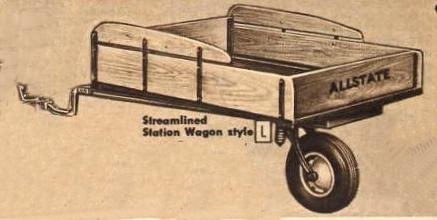 The Station Wagon
The Station Wagon
In the years following World War II, as consumer demand for recreational and utility equipment grew once more, Sears continued to refine and expand its popular line of single-wheel trailers. In the Fall 1949 Sears Catalog, the company introduced a new variation to its lineup—an updated model that shared the same trapezoidal steel frame and load-carrying capacity as the earlier version, but differed primarily in the design of its cargo box. This new model was marketed as the “Station Wagon” version, an evocative name that suggested both style and practicality for postwar American families on the move.
The Station Wagon trailer featured a more sophisticated and visually appealing construction. Its two-piece side panels were crafted to create a distinctive “streamlined” look, with the upper panels shaped in a teardrop contour and separated from the lower panels by a narrow horizontal gap. Unlike the standard model, which was finished in solid blue paint, the Station Wagon’s body was varnished instead of painted, leaving the natural wood grain elegantly visible—a detail that gave it a warm, handcrafted appearance and aligned with the popular design aesthetics of the late 1940s.
According to the 1949 Sears Fall Catalog, the Station Wagon model was priced at $67.95, a modest reduction from its previous spring catalog price of $69.95. By the time the 1950 Sears Fall Catalog was released, the price had been further reduced to $64.95, and the trailer now proudly displayed the “ALLSTATE” logo across its rear tailgate, reflecting Sears’ ongoing effort to unify its automotive and trailer products under the recognizable brand name.
The 1952 Sears Fall Catalog marked the final appearance of the Station Wagon trailer in Sears’ product listings, with its price reverting to $67.95. After this year, the model was quietly discontinued, bringing an end to a brief but memorable chapter in Sears’ postwar trailer offerings—a period that showcased the company’s innovation, design experimentation, and ability to adapt to the evolving tastes of mid-century American consumers.
The 1961 Spring-Summer catalog marked the beginning of a new era with the introduction of a leaf spring wheel assembly for trailers. Although this particular trailer was only featured in that one catalog, it stands out with unique characteristics not seen in other Sears trailers of the time. Unlike most Sears trailers, which were typically built in Chicago, this model was produced in a factory near Des Moines, Iowa. The inclusion of the leaf spring in this design hinted at future trends in trailer suspension.
This trailer has several distinctive features, including a curved leaf suspension, a hydraulic shock absorber, and front mounting arms that curve downward at an angle. These elements set it apart from its predecessors. The body design carried over some aspects from the earlier wood box trailer, including a dark blue color scheme and the iconic “ALLSTATE” U.S. map logo prominently displayed on the front. It also appears to have removable front and possibly rear panels, similar to the earlier Wood Box trailers.
While it may have been short-lived in Sears’ lineup, this trailer from the 1961 catalog remains a fascinating piece of history, showcasing innovative design choices and a glimpse into the evolution of wheel assembly technology.
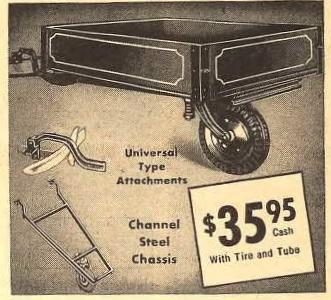 In the Spring 1941 catalog, the “Cross Country” trailer disappeared. Instead, the Chicago-made trailer was joined by another trailer from the same source in Chicago. This newest trailer was designed to replace the “Cross-Country” in the product line-up, since it was sold for around the same price and carried the same 750# load. It had a wooden box measuring 54″ x 48 ” x 9-3/4″, using apparently the same construction as its little brother. The box differed not only in dimension but in its detailing, with an ornamental pattern painted in a different color than the main color of the panels. The new trailer also used a different frame, a trapezoidal “channel steel” chassis instead of the X-frame used on the smaller model. The same “universal mount” tongues and new coil-spring suspension were used for both trailers. The prices were $29.95 and $34.95. The Fall-Winter 1942 catalog showed the same two trailers with the same ordering numbers and specs, at slightly increased prices. After this catalog, no single-wheel trailers show up in the catalog until 1948. I presume that they were discontinued for the duration of World War II, since manufacturing was devoted primarily to the war effort and things like steel and tires were in short supply. There was a kit offered in the Fall-Winter 1945 catalog for a four-wheel trailer, but no other utility trailers were offered.
In the Spring 1941 catalog, the “Cross Country” trailer disappeared. Instead, the Chicago-made trailer was joined by another trailer from the same source in Chicago. This newest trailer was designed to replace the “Cross-Country” in the product line-up, since it was sold for around the same price and carried the same 750# load. It had a wooden box measuring 54″ x 48 ” x 9-3/4″, using apparently the same construction as its little brother. The box differed not only in dimension but in its detailing, with an ornamental pattern painted in a different color than the main color of the panels. The new trailer also used a different frame, a trapezoidal “channel steel” chassis instead of the X-frame used on the smaller model. The same “universal mount” tongues and new coil-spring suspension were used for both trailers. The prices were $29.95 and $34.95. The Fall-Winter 1942 catalog showed the same two trailers with the same ordering numbers and specs, at slightly increased prices. After this catalog, no single-wheel trailers show up in the catalog until 1948. I presume that they were discontinued for the duration of World War II, since manufacturing was devoted primarily to the war effort and things like steel and tires were in short supply. There was a kit offered in the Fall-Winter 1945 catalog for a four-wheel trailer, but no other utility trailers were offered.
Anthony Company Incorporated.
1912 – 1917 – While working at the Streator, IL lumber yard, William C. Anthony has the idea for a dump bed to be mounted on Ford Model T’s. Early production units are hand made, but demand grows quickly. To expand production Anthony Company is incorporated and production is moved to a larger facility across town. From 1926 – 1938, the company leads the way developing hydraulic systems of all kinds used to transport cargo, becoming a weighty player in the transportation equipment industry. Inventing continued and the hydraulic lift gate was introduced. It was the brainchild of Frank Novotney, a Streatorite and employee of Anthony Company. The name “lift gate” was copyrighted. (This is the era it is believed that these trailers were produced.) Post war, the Anthony Lift Gate was a the primary focus of the company.
These trailers had a very industrial leaf spring suspension and were advertised with a few different body configurations. The plate riveted to one of the remaining trailers says “Timken Bearing Equipped” with a Date and Serial location. Dates and history from the Anthony Lift Gates page and an article no longer on the web, but luckily we kept a copy.
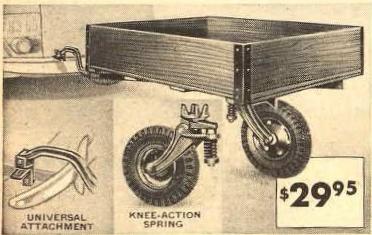
X-Frame
The Fall 1940 catalog showed the CrossCountry and a new, different trailer, with a “Knee-Action spring” (using a true coil-spring suspension) and the tongues that would become associated with Allstate trailers. These tongues were castings shaped into a sort of “question mark” shape and were designed to fit over or under a car’s bumper and attach to either the bumper brackets or the car’s frame. This trailer had an X-shaped frame and was only available for 2 years from Sears. The box was 48″ x 42″ x 9-3/4″, had 4 wood sides with “steel corner angles and four steel cross members,”. It was rated for 500 pounds of cargo, came from a “factory in Chicago”, and sold for $29.95
The earlier “Cross Country” trailer, with its 750 pound load capacity, was still available, with its Niles, Ohio source, and was priced at $37.95.
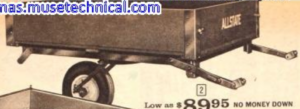
In the 1961 Sears Fall-Winter Catalog, Sears introduced another exciting new trailer to their lineup, continuing their tradition of innovation. This time, it was a wood box-bodied single-wheel trailer, but with a significant upgrade—an entirely new chassis. This model marked the debut of the straight leaf spring suspension system, along with height-adjustable arms, features that would go on to set the standard for all subsequent Allstate trailers.
The wood box body of this trailer seems to have retained the convenient removable front and rear panels from earlier models, allowing for easy access and versatility in loading and unloading cargo. This design choice continued the practical functionality that Sears Wood box trailers were known for.
In a nod to its roots, the trailer also brought back the classic “ALLSTATE” logo, proudly displayed as a symbol of quality and reliability. Unlike many of its predecessors, which were typically manufactured in Chicago, this trailer was factory-built in Des Moines, Iowa, further distinguishing it from earlier models.
This introduction in the Fall-Winter catalog wasn’t just another addition to the lineup; it was a step forward in trailer design, setting the stage for the evolution of future Allstate trailers. Whether you’re a fan of classic trailers or just appreciate clever engineering, this model from 1961 is a standout, combining tradition with innovation in a way that only Sears could.
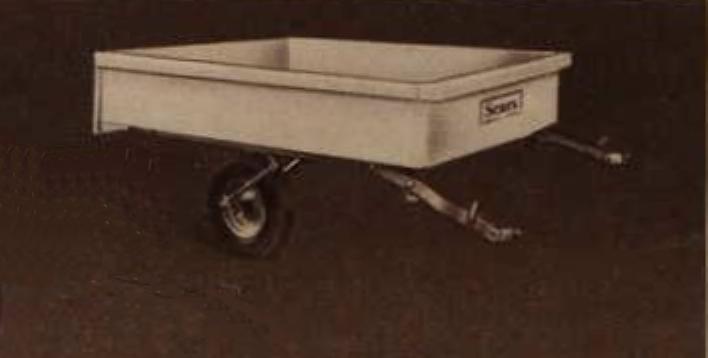
Allstate – Steel Box
By the Fall–Winter 1963 Sears Catalog, the company proudly introduced what it described as “Our Best ALLSTATE All-Steel Trailer.” This announcement marked yet another refinement in Sears’ long-running tradition of practical, affordable, and versatile hauling equipment. For the first time, Sears offered both a two-wheel and a single-wheel version of the trailer, each designed with the same general dimensions and styling. The construction featured a separate steel frame and detachable body, a configuration that allowed greater customization for owners who wished to adapt the trailer to specific uses. For those seeking a more economical option or preferring to construct their own cargo body, Sears also sold the frame alone for $10 less than the complete trailer. The standard color finish for both models was a clean beige enamel, consistent with the restrained industrial aesthetic popular during the early 1960s.
Sometime after the publication of the 1965 Sears Fall Catalog, a notable design evolution took place: the company discontinued the separate frame offering and transitioned the trailer to a fully integrated unibody construction. This advancement meant that the frame and body were now a single, welded structure, increasing rigidity while reducing assembly complexity. The unibody design was also cleverly engineered to accommodate both single-wheel and two-wheel configurations. Mounting holes for the two-wheel leaf spring suspension were located on either side of the body, while a central set of holes was provided for attaching the single-wheel assembly, making the chassis truly multipurpose.
At the time of its introduction, the factory price for the single-wheel version began at $85.00, a competitive figure for a fully steel-bodied trailer of its size and quality. By the Spring 1964 Catalog, Sears expanded the line’s versatility by offering an optional steel top, designed to provide all-weather protection for cargo. The top was hinged for easy access and sold separately for $37.50, appealing to customers who needed a durable, enclosed storage option for travel or utility use.
Over the following decade, the All-Steel trailer line underwent a series of incremental design and branding updates that reflected both functional improvements and evolving mid-century styling trends:
-
1966 Fall Catalog: The trailer’s front logo changed from ALLSTATE to the more contemporary SEARS mark, signifying a shift in branding as Sears phased out its Allstate name for many automotive products. The color changed from beige to tan enamel, and the price slightly decreased to $77.00.
-
1967 Spring Catalog: The finish was updated again, this time to a white enamel coating, aligning with the clean, modern look of the late 1960s. The price, however, rose to $89.00.
-
1968 Fall Catalog: Safety updates began appearing, with the addition of two rear reflectors, and the price increased to $124.95.
-
1969 Spring Catalog: Four side reflectors were added for improved visibility, and the price adjusted to $119.99, likely reflecting material cost fluctuations.
-
1970 Spring Catalog: Major safety upgrades arrived this year — the trailer now included two rear taillights along with the four side reflectors. In earlier years, taillights had been available only as an optional add-on. The new model sold for $139.99.
-
1970 Fall Catalog: The four side reflectors were upgraded to side marker lights positioned in the same locations, enhancing nighttime visibility without changing the $139.99 price.
-
1971 Fall Catalog: The color shifted once again, this time to a rich Cinnamon Brown enamel, but the side lights were downgraded back to four reflectors. The price rose modestly to $149.99.
-
1972 Spring Catalog: Sears added chrome-plated bumper brackets, giving the trailer a more polished, automotive appearance, and increased the price to $154.49.
-
1975 Spring Catalog: Reflecting inflation and rising manufacturing costs during the mid-1970s, the price jumped significantly to $224.95.
Through these years, Sears’ single-wheel and two-wheel trailers remained reliable, accessible options for everyday consumers—favored by campers, tradesmen, and travelers alike. The progression from separate-frame construction to unibody design, along with evolving finishes, safety equipment, and branding, illustrates Sears’ commitment to continuous improvement and adaptation to modern tastes throughout the 1960s and 1970s.